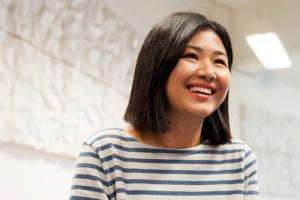Sumin Zhao, photo by Joanne Saad
Digital content aimed at preschool-aged children is leading to a contemporary conundrum for parents and early childhood teachers, according to Dr Sumin Zhao.
The linguist and Chancellor's Postdoctoral Research Fellow in the Faculty of Arts and Social Sciences, says, thanks to the digital revolution, children are being exposed to digital technology earlier in life. Educators are also being encouraged to incorporate new modes of learning into early childhood classrooms.
As a result, parents and teachers need help determining how to pick and choose the tools that will be beneficial to children's learning. It's a big job, particularly given the sheer volume of digital content that is now available for young children.
"What parents and teachers are facing is that they don't know how to choose. What are the guidelines for what is working, what isn't working, what is actually good for children?" Zhao says.
Her particular area of interest is in mobile apps, or web applications that are accessible via tablets and other smart devices. She and her colleagues are seeking to understand how the introduction of apps has changed family literacy practises and how their use can maximise literacy learning for children aged three to five. They are also seeking to build a series of guidelines to help parents and teachers select and use apps more effectively.
Originally from Shanghai, Zhao came to Sydney 10 years ago to complete her postgraduate studies. A PhD at the University of Sydney, followed by a research position at UTS, led to a UTS Chancellor's Postdoctoral Research Fellowship that commenced in early 2013.
Her interest in linguistics, particularly when it comes to digital content, is part passion for "nerdy" subject matter and part personal belief in the importance of positive educational experiences for children.
"The nerdy reason is that analysing digital texts is more challenging for linguists than just analysing plain text," she says.
"The other reason, I think, is that I've always been interested in early childhood education."
Research has shown family literacy practises, like bedtime stories and parents and children reading together, have a profound impact on how well children do at school. Students whose learning at home is poorly matched to school curriculum, or disadvantaged students who don't have access to the same resources as their peers, tend to fall behind.
"You reflect back and you realise your friends are just as smart as you but because what they were taught at home was so different to what the school did, they were kind of being filtered out of the school system," Zhao says.
In the digital era, being able use digital technologies effectively is not a given for all children, despite a widespread belief that kids today are 'digital natives' who have been brought up on a diet of iPads and smart phones. Zhao cautions being able to access digital content is not the same as being able to extract valuable information from it that impacts learning in a positive way.
"It's the same as whether you use a book as a brick, or whether you use a book to learn things," she says.
"There are also lots of children who've never touched an iPad at home, and they don't know how to engage these apps."
While her research is still in its early stages, Zhao hopes the outcomes will be useful both in the home and in the classroom. For teachers, she wants the guidelines to be instructive both in terms of helping them choose useful apps to use in class, and in showing them how to integrate the apps into their teaching to enhance learning outcomes.
Provided by University of Technology, Sydney





















